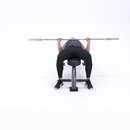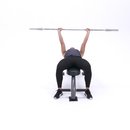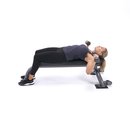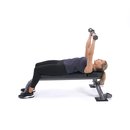Shoulders | Back | Arms | Chest | Legs | Abs & Calves | Final
It's easy for guys to get motivated to train their chest; good overall chest development is one of the most sought after goals of male bodybuilders. Many women, however, lack the desire or strength to train their chest. In addition, all the muscles of the chest aren't visible to women, so they often forget about training them.
Why should you train chest, then? Aside from the fact that a well-developed chest gives you plenty of functional strength, it can help lift and fill out the appearance of the upper body. The coveted center "chest line" is a true badge of a strong and fit woman.
The chest is primarily comprised of the pectoralis major and pectoralis minor (also known as "pecs"). The pectoralis major is comprised of two heads—the clavicular (upper) and the sternal - with the latter comprising most of the pectoralis muscle group. The pectoralis minor is located on the outside of the chest. These fan-shaped muscles are responsible for moving the upper arm towards and across the chest and also allow for forward movement away from the body.
While only two primary muscles make up this body part, it's one of the largest in the body and requires a well-rounded training program to develop full, strong, chest muscles. Also important to the look of the chest are the front deltoids (specifically how they "tie-in" to the upper and outer pecs) and the serratus muscles.
Training Basics
Compound Movements
- Bench Press—variations: Incline, Flat, Decline - Grip Widths: Wide, Normal, Close - Equipment: Barbell, Dumbbell, Smith
- Hammer Machine Press
- Push Up—variations: Elevate Feet, Elevate Hands, Weighted, Assisted—Plyometrics: Clap, Depth—Hand Placement: Wide, Normal, Close, One Arm - Equipment: Exercise Ball, Core Ball, Medicine Ball
- Chest Dip—variations: Weighted, Assisted—Equipment: Dip Bar, Bench
- Medicine Ball Toss
Isolation Movements
- Fly—variations: Incline, Flat, Decline - Equipment: Dumbbells, cables
- Cable Crossovers—variations: High, low
- Pullover—variations: Dumbbell, EZ-Bar, cable
- Pec Deck Machine
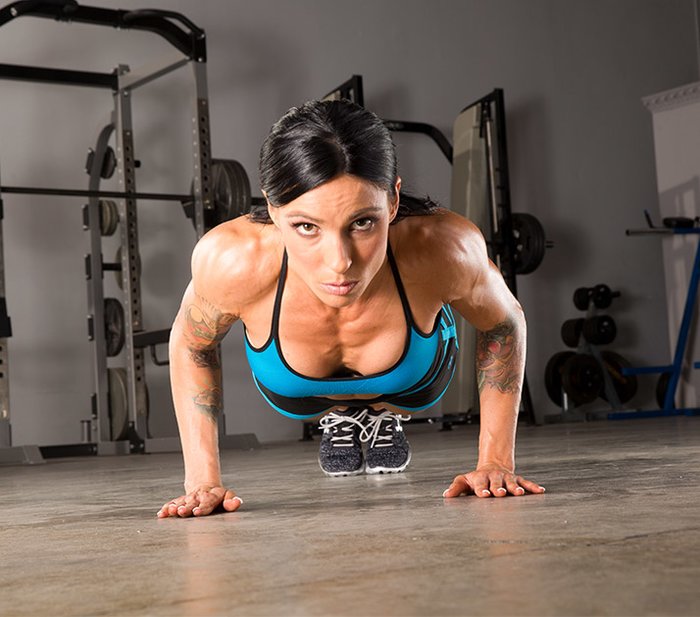
Developing Your Training Program
Because the chest muscles are so big, they have to be hit with a variety of exercises and a larger number of sets to fully fatigue the muscle fibers. When developing your program, choose 2-3 compound movements and 1-2 isolation movements to ensure you're getting ultimate stimulation for growth and strength from your chest workouts.
Because the pec muscles fan out in many directions, you can develop your program to target the pecs by region. Upper and lower chest can be individually targeted. In addition, you can shift the focus on outer or inner pecs, depending on the exercises you choose and how you perform them.
To target the upper chest (sternal head), which is the most visible portion of this muscle on a woman, choose incline movements. Choosing flat bench exercises targets the overall chest, while opting for decline movements hits the lower chest. All areas are important for overall development in strength and size.
The outer chest is important as well. It is very visible in the area that ties in to the front deltoid. This can be targeted with standing flys and a variety of dip exercises.
When properly developed, the inner pecs give that coveted line down the center of the chest. To develop yours, concentrate on peak contraction and squeeze the chest at the top of your pec deck and fly exercises.
Sets and Repetitions
Generally speaking, most people benefit from performing 10-15 repetitions and 2-3 working sets of a particular exercise. This will differ based on your training history, current fitness level, and goals.
Women focusing on maintenance should stick to 2-3 sets of 12-15 repetitions. Individuals aiming for mass gains should perform 3-4 sets of 8-12 repetitions. In order to gain strength, you should perform 3-4 sets of 6-10 repetitions.
You can incorporate one, two, or all three rep ranges into your program for variety. For example, women looking to gain size and strength would do well to alternate the 8-12 and 6-10 rep ranges every other workout.
Additional Muscles Often Trained With Chest
The muscles of the chest are very large, so some people prefer to train them on their own day. This is a great way to ensure you are hitting the chest muscles fully and completely exhausting them.
Another option is to train chest with shoulders and triceps. Such is the program of a trainee on a push/pull split. The push side of this split places exercises together that require you to push the resistance away from the body on the positive portion of the exercise.
In addition, the shoulder and triceps are hit secondarily in many chest exercises, which makes this split a good choice for the trainee who wants to save time and/or keep the intensity high.
Trainees who have already reached their desired amount of development can condense their workouts as such for maintenance purposes, as the stimulation from less volume is sufficient at that point.
If you like the idea of dedicating chest to its own day, but you lack the time to follow a five or six day split, you can choose to pair chest with biceps. By pairing these two opposing muscle groups, you can train chest completely without sacrificing strength needed to train shoulders or triceps.
The biceps can then get a completely taxing workout as well, since they are not worked secondarily in any chest exercises.
The serratus muscles (boxer's muscles) are also commonly trained with chest. These are the finger-like muscles underneath the armpit. They are often hit secondarily in movements such as dips, pull-ups, and pullovers, so they can be trained with either back or chest.
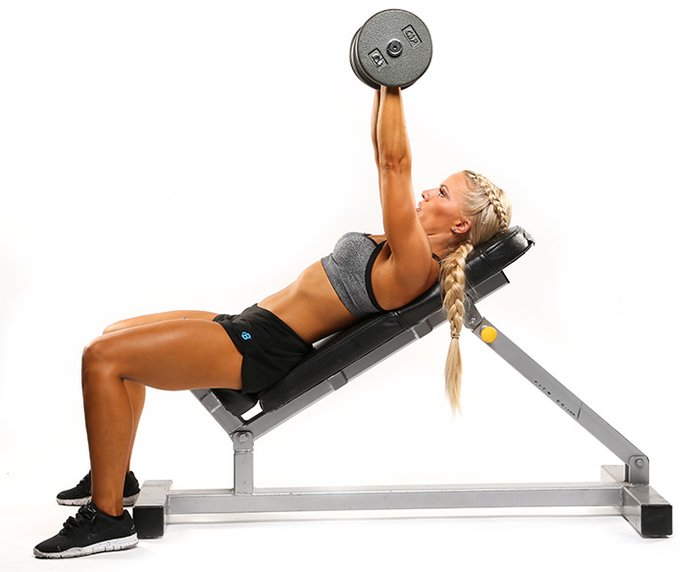
Frequency, Duration and Intensity
Since chest is so large, I recommend training it by itself or with only one other muscle group, if you are seeking a lot of development. I definitely do not advise training chest with back or legs, as these large body parts would require a very long, intense training session that would leave you without enough energy to finish your workout with the desired amount of intensity.
Your workouts should last 30-45 minutes if you train chest alone, and 45-60 minutes if trained with additional body parts.
It's fairly easy to keep the intensity high during your chest workouts. The pecs are easy to target and can easily become fully fatigued because of the variety of shock tactics you can employ to your chest training. Be sure to train to absolute failure on your last two sets, and near failure on your first two sets, to keep your intensity high.
Targeting Specific Goals
Adding Mass
The chest is a difficult muscle to build for many women. Most of our strength is in our lower body, so we have to work extremely hard to build up the size and strength of the chest. This can be done by performing at ultimate intensity, shocking the muscles with a variety of exercises and equipment, and pushing the body to lift heavier weights week after week.
You must include flat barbell bench presses as the staple mass-building exercise in your program. This power lifting movement builds strength and size like no other. Just be sure your form is down pat and you have a spotter to help push out those forced reps!
Training At Home
Training the chest at home is fairly easy, as most of the exercises require basic equipment. If you have a bench, barbell, and a few sets of dumbbells, you can completely train your chest with almost all of the exercises listed above. You can substitute bands or cables for the free weights, which won't give you as heavy a workout, but can still yield an effective workout if you train intensely enough.
Medicine balls can be used to perform push-ups on, as well as the medicine ball toss, and pressing movements.
An exercise ball can be used to elevate the feet in a push-up, or to create an unstable base for pressing and flying exercises that also target the core muscles.
Exercise Variety
There are a few basic exercises that target the chest, and there is a huge number of variations of these basics, so you should never get bored or let your program become stale. By changing the angle of the bench, your grip width, or the type of equipment used, you can target your muscles in new ways to keep your program fun, interesting, and effective.
Varying your exercises not only keeps the training fun and prevents plateaus; it is essential in developing a complete chest. If you prefer only incline movements, your lower chest will be lacking, causing a strength and perhaps size imbalance. Keep your program varied by choosing incline and decline movements every 2-3 workouts. Perform them in different orders to fully stress the targeted area of the chest in each workout.
Symmetry
If your chest development is lacking, it will be clearly visible with a shallow chest and no pec-delt tie-in. In physique competition, it's important to have a full chest and a nice midline descending from the upper down through the lower chest.
In particular, if a female competitor has breast implants, she may need to put in extra work on her chest to prevent an extreme shallow appearance where the breast tapers down to the pectorals.
You may target individual portions of the chest if your desire is to bring up one or another of the chest muscles. Choosing flat bench exercises targets the overall chest, while opting for decline movements hits the lower chest.
To target the upper chest (clavicular head), which is the most visible portion of this muscle on a woman, choose incline movements. All areas are important for overall development in strength and size.
The outer chest (pectoralis minor) is important as well. It is very visible in the area that ties in to the front deltoid. This can be targeted with standing flys and a variety of dip exercises.
When properly developed, the inner pecs give that coveted line down the center of the chest. To develop yours, concentrate on peak contraction and squeeze the chest at the top of your pec deck and fly exercises.
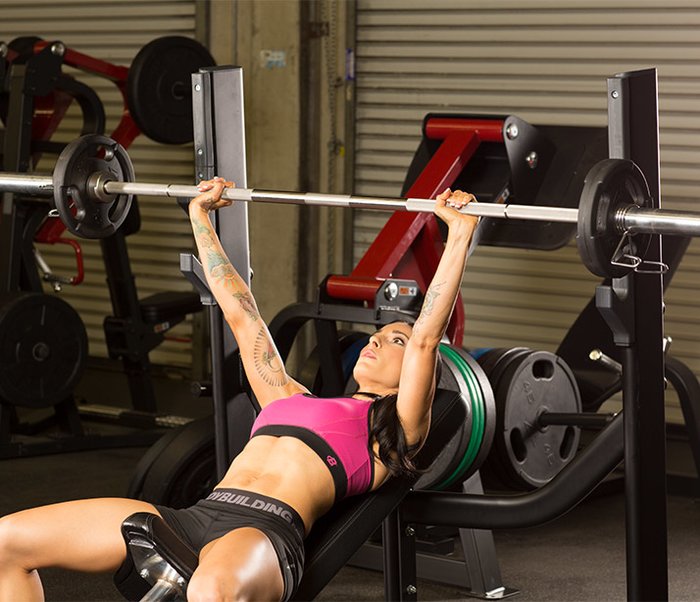
Isolation
The chest muscles are fairly easy to isolate during training. To minimize back and shoulder involvement, begin your pressing movements with the back slightly arched and the scapulae retracted (shoulder blades depressed). Not only will this help to better target your pecs by providing a more stable base, it will also prevent injury to the shoulder joints.
Isolation exercises such as the pec deck machine and flys offer complete isolation directly to the pectorals. These exercises are great for shaping and defining the chest. Perform your flying movements with the elbows slightly bent in a fixed position throughout the exercise.
To maximize peak contraction, stop the positive portion of the rep while the dumbbells or cables are still 3-4 inches apart, and squeeze the pecs together for several seconds. To get even more contraction, turn the pinkies in towards each other at the very top of the movement.
Prioritization
If your chest development is lacking in regards to the rest of your body, you may wish to implement the prioritization principle to your training program. Try training chest by itself once per week with pressing and flying movements at all three angles (incline, flat, decline).
Another method of prioritization is to train chest with power movements one week and intense shaping exercises the second week. The power exercises build sheer strength and mass, while the shaping exercises help to form and define the chest muscles.
The staple power movement for chest is the barbell bench press. If you aren't including it in your program, this may be the reason your chest is lacking! Add it to your program right away, but make sure you know the correct form and have a spotter until you are comfortable with the exercise.
Go Heavy, Go Hard?
The chest is a large, powerful body part that can lift a large amount of weight. While women are usually weaker in the upper body than the lower body, through hard work and diligent training, many women have successfully built strong and powerful chest muscles.
The chest responds well to heavy weights and low reps in the 6-8 range. Going heavy and hard on your flat bench barbell presses is essential for mass and strength gains. Perform this staple movement every week if you use the prioritization principle, or every other week if you prefer the power lifting split.
If you typically train without a spotter, at the very least this is the one exercise that you'll need a spotter for. Grab the guy next to you for help with your heaviest sets. This is necessary if you want to increase poundage and, in turn, strength and size. It's also nearly impossible without a spot.
Constantly aim to increase your poundage in bench press, even if only by a few pounds. If you don't complete the desired number of reps, don't feel bad. As long as you've stimulated your chest with a heavier weight, adaptation will eventually occur and you will increase your strength to be able to complete your set at the new higher weight.
Sample Chest Training Program
Workouts 1 and 2 are to be paired together in the power lifting training split. Alternate between the two workouts every other week.
If you wish to pair chest with biceps, choose two compound pressing movements at varying angles and one isolation (fly) movement. Perform 2 biceps exercises to complete the workout.
An ideal split for those looking to maintain their strength and size would be to combine chest training with shoulders and triceps. If you choose this option, pick one compound movement and one isolation movement for chest and shoulders. Then pick 1-2 triceps exercises to finish off the workout. (See the Shoulders Training Guide and the Arms Training Guide for sample shoulders and triceps exercises.)

BodyFit
$6.99/month- 2,500+ expert-created single workouts
- 3,500+ how-to exercise videos
- Detailed workout instruction
- Step-by-step workout tips
- Training at gym or at home
- Access to Workout Plans
- Access to Bodyfit App
- Store Discounts
Already have a Bodybuilding.com account with BodyFit? Sign In

What comes with BodyFit?

- Instructional Videos
Don't risk doing a workout improperly! Avoid injury and keep your form in check with in-depth instructional videos.

- How-to Images
View our enormous library of workout photos and see exactly how each exercise should be done before you give it a shot.

- Step-by-Step Instructions
Quickly read through our step-by-step directions to ensure you're doing each workout correctly the first time, every time.

BodyFit
$6.99/month- 2,500+ expert-created single workouts
- 3,500+ how-to exercise videos
- Detailed workout instruction
- Step-by-step workout tips
- Training at gym or at home
- Access to Workout Plans
- Access to Bodyfit App
- Store Discounts
Already have a Bodybuilding.com account with BodyFit? Sign In

What comes with BodyFit?

- Instructional Videos
Don't risk doing a workout improperly! Avoid injury and keep your form in check with in-depth instructional videos.

- How-to Images
View our enormous library of workout photos and see exactly how each exercise should be done before you give it a shot.

- Step-by-Step Instructions
Quickly read through our step-by-step directions to ensure you're doing each workout correctly the first time, every time.
Pyramid up in weight on every set. Each set should become increasingly difficult, and ultimate failure should be reached on the final two sets. Rest time between sets should be 1 - 1 1/2 minutes.



